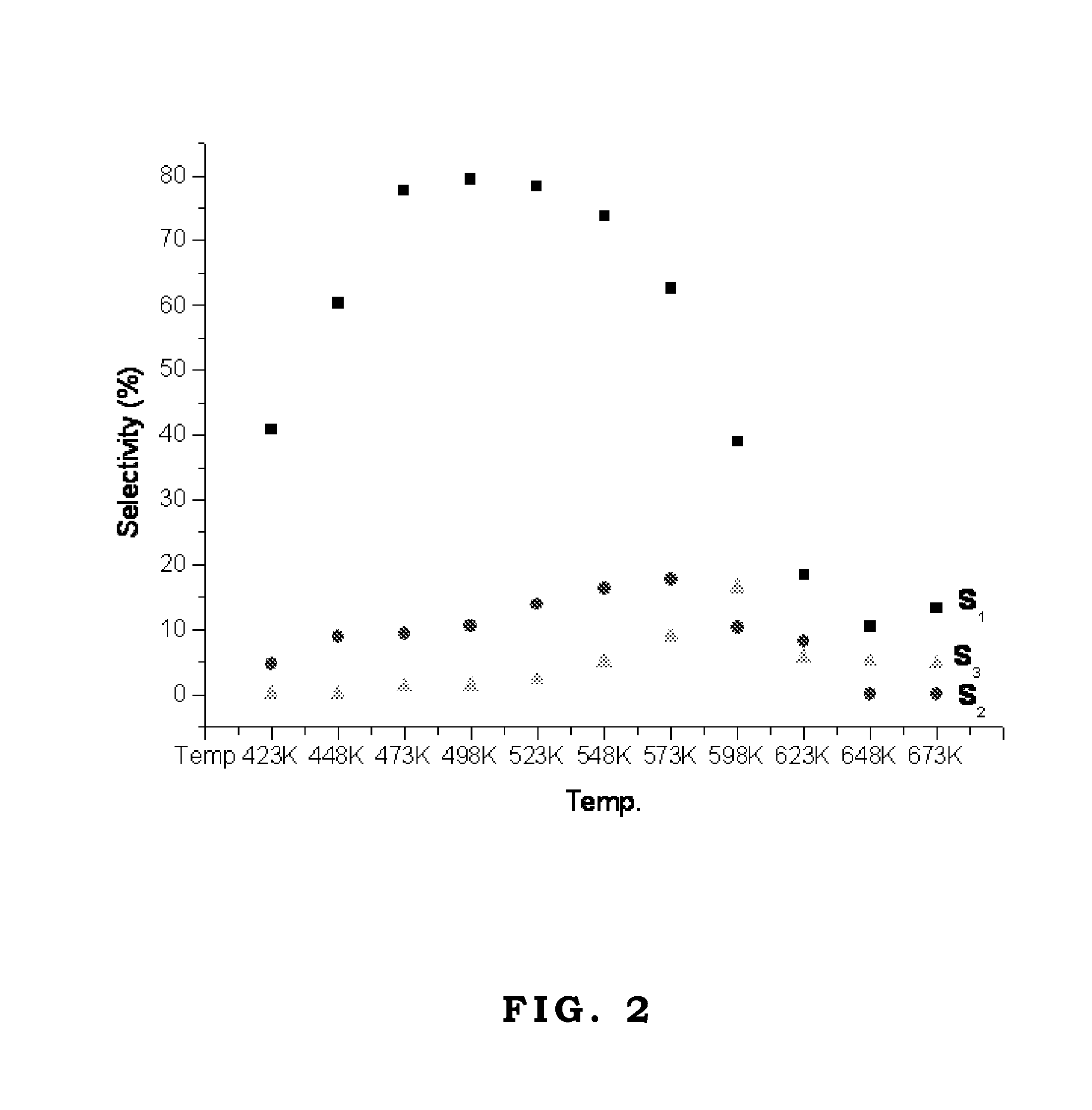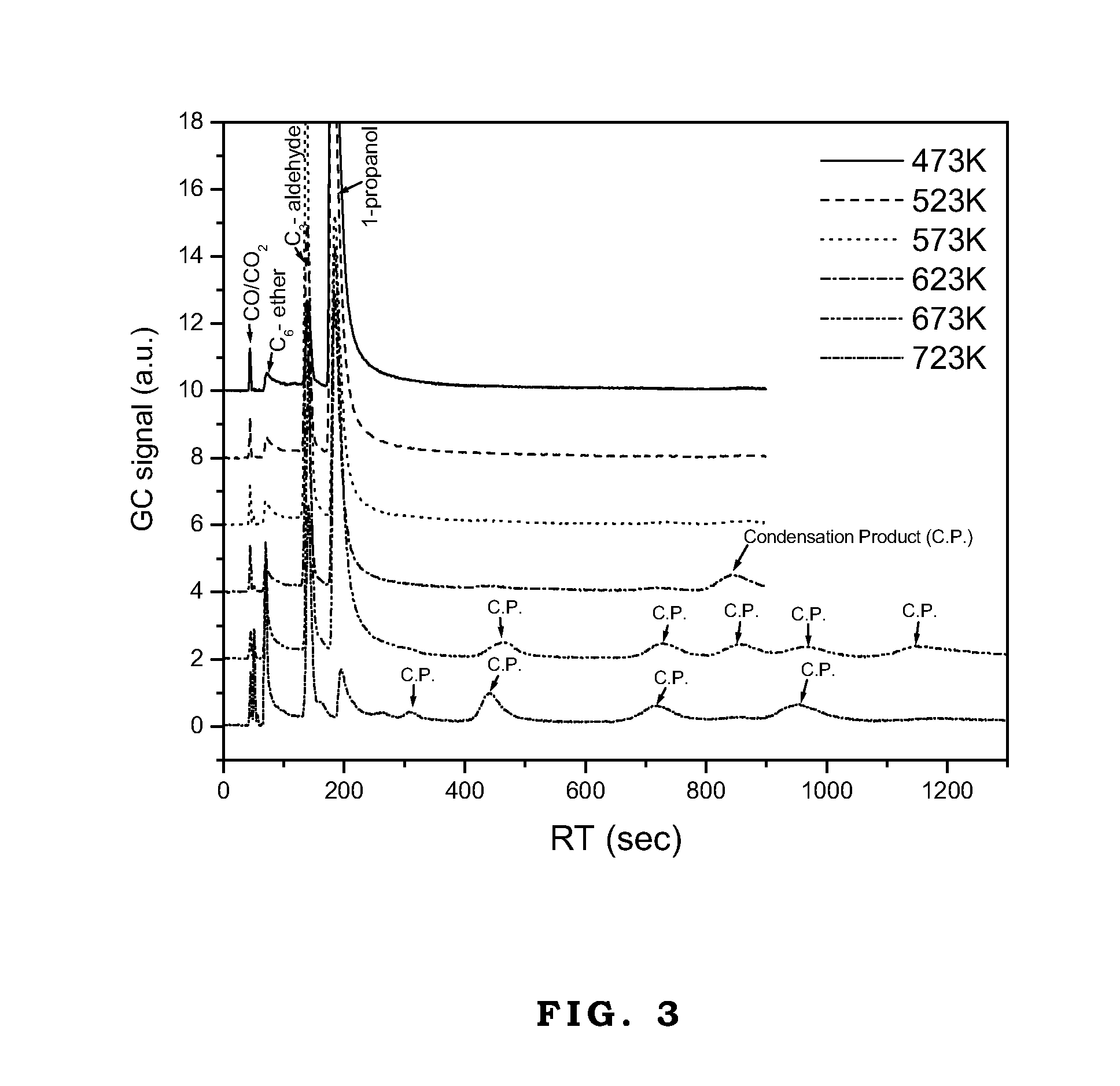Catalytic synthesis of oxygenate from alcohol
a technology of oxygenate and catalytic synthesis, which is applied in the preparation of carbonyl compounds by oxidation, physical/chemical process catalysts, metal/metal-oxide/metal-hydroxide catalysts, etc., can solve the problems of energy consumption and uneconomic processes, and achieve the effect of reducing the need for petroleum raw materials and low catalytic temperatur
- Summary
- Abstract
- Description
- Claims
- Application Information
AI Technical Summary
Benefits of technology
Problems solved by technology
Method used
Image
Examples
example 1
Method for Preparing Cu—Zn—Mg—Al Based Catalyst
[0018]Dissolve copper nitrate and zinc nitrate compounds in water and use impregnation method to let copper and zinc impregnated on the flake structure of Mg—Al. Next, dry by vacuum. Carry out oxygen calcinations at 673 K. to form Cu—Zn—Mg—Al based catalyst. Set the catalyst in a dry box for use.
[0019]In a second embodiment of the present invention, a method for catalytic synthesis of oxygenate from alcohol is disclosed. At first, a copper-containing catalyst is provided. The selection and preparation methods are the same as those in the first embodiment. Next, a reduction process for the copper-containing catalyst is carried out. Due to large surface area of the catalyst, oxygen gas in air is very easy to adsorb on the catalyst and thus regeneration or reduction treatment of the catalyst is required before use. For example, the reduction process can be performed under environment with hydrogen gas and temperature of 473 K.-573 K. Final...
example 2
Three-component Catalyst
[0020]The reaction pathway of the catalytic synthesis of oxygenate from alcohol according to the present invention comprises the following three species:[0021]S1. alcohol-aldehyde or ketone[0022]S2. alcohol-ester or ether[0023]S3. alcohol-oxygenate (condensation, carbon chain lengthened).
The oxygenate synthesized by the third mechanism S3 may have a continual side-reaction, such as hydrogen addition reaction to form glycol (Its carbon number is larger than alcohol initiator.) or hydrogen addition and dehydration reaction to form alcohol, aldehyde, or ketone (Its carbon number is larger than alcohol initiator.). As the reactant is ethanol, FIGS. 1 and 2 shows the diagrams of the pathway selectivity of the catalytic reaction over two commercial Cu / ZnO / Al2O3 catalysts, respectively.
example 3
Four-component Catalyst
[0024]Cu—Zn—Mg—Al based catalyst after hydrogen reduction treatment is used to catalyze the synthesis of carbon-chain-lengthened oxygenate from methanol under the conditions that the temperature is 523 K., the methanol partial pressure is 200 torr, and the weight-hourly-space-velocity (WHSV) is 0.2h−1. The selectivity to condensation products is at least 25%. The detailed reference is shown in Table 1.
[0025]
TABLE 1Product analysis of methanol reaction catalyzed overCu—Zn—Mg—Al four-component catalystAldehydeTotalor KetoneEsterEtherAlcoholC2-C9%(%)(%)(%)(%)C212.1 2.12.27.40.4C312.912.9———C43.7 3.0——0.7C55.7 3.30.61.8—C66.1 3.01.12.0—C715.912.50.51.71.2C814.414.4———C926.125.1—1.0—Total76.34.413.92.3
PUM
| Property | Measurement | Unit |
|---|---|---|
| temperature | aaaaa | aaaaa |
| temperature | aaaaa | aaaaa |
| temperature | aaaaa | aaaaa |
Abstract
Description
Claims
Application Information
 Login to View More
Login to View More - R&D
- Intellectual Property
- Life Sciences
- Materials
- Tech Scout
- Unparalleled Data Quality
- Higher Quality Content
- 60% Fewer Hallucinations
Browse by: Latest US Patents, China's latest patents, Technical Efficacy Thesaurus, Application Domain, Technology Topic, Popular Technical Reports.
© 2025 PatSnap. All rights reserved.Legal|Privacy policy|Modern Slavery Act Transparency Statement|Sitemap|About US| Contact US: help@patsnap.com



